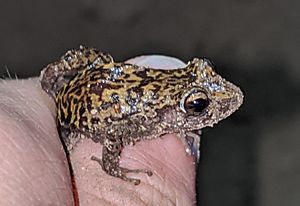Eleutherodactylus guanahacabibes facts for kids
Quick facts for kids Eleutherodactylus guanahacabibes |
|
|---|---|
 |
|
| Conservation status | |
| Scientific classification |
The Eleutherodactylus guanahacabibes is a special type of frog. It belongs to a group of frogs called Eleutherodactylidae. This frog is found only in one place: Cuba. It gets its name from the Guanahacabibes Peninsula in Cuba, where it lives.
These frogs like to live in warm, wet places. Their homes are usually subtropical or tropical moist lowland forests. They also live in rocky areas and even inside caves. Sadly, this frog is in danger. Its home is shrinking because of habitat loss. This means the places where it lives are being destroyed.
Meet the Guanahacabibes Frog!
This small frog is known by its scientific name, Eleutherodactylus guanahacabibes. It is a unique creature found only on the island of Cuba. When an animal or plant lives only in one specific place, we call it endemic. So, this frog is endemic to Cuba.
Its name, guanahacabibes, comes from the Guanahacabibes Peninsula. This is a beautiful area in western Cuba. Scientists gave the frog this name to show where it was discovered.
Where Does It Live?
The Guanahacabibes frog loves certain types of environments. It prefers forests that are warm and moist all year round. These are often called lowland forests. You might also find these frogs hopping around rocky areas. Sometimes, they even make their homes inside cool, damp caves.
These different places provide the frog with shelter and food. They are important for the frog's survival.
Why Is It in Danger?
Even though these frogs have special homes, they are facing a big problem. The main threat to the Eleutherodactylus guanahacabibes is habitat loss. This means that the forests, rocky areas, and caves where they live are disappearing.
People might clear forests for farming or building. This takes away the frog's home. When their habitat is lost, these frogs have nowhere to live. They also lose their food sources and places to lay their eggs. This makes it very hard for them to survive and have babies. Protecting their homes is very important to help these unique frogs.
See also
 In Spanish: Eleutherodactylus guanahacabibes para niños
In Spanish: Eleutherodactylus guanahacabibes para niños


